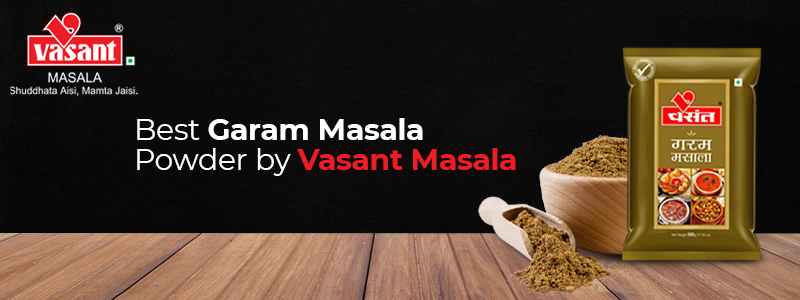
Garam masala is a warming combination featuring cardamom, cinnamon, cloves, and peppercorns among other things. It is a famous spice combination from Northern India that is used to flavour soups, stews, curries, and other Indian dishes.
Is there a bottle of garam masala in your spice cabinet?? This spice mix is popular in Indian cooking, and it's quite warming and aromatic. Even if you don't have the mix itself, you most certainly have all of the ingredients. What exactly is garam masala, though? Continue reading to learn more about the spice blend.
Garam masala is a famous spice combination from Northern India that is used to flavour soups, stews, curries, and other Indian dishes. The best garam masala powder can be purchased in the spice area of your grocery store, at Vasant Masala's online masala store, or made from whole spices.
What is Garam Masala?
Garam masala is a warming combination featuring cardamom, cinnamon, cloves, and peppercorns (among other things!). Its name means "hot or warm spices," although the flavours aren't spicy. This one-of-a-kind, flavourful spice combination is meant to strike a variety of flavour notes: It's slightly flowery, sweet, warm, earthy, and earthy. This spice blend varies from family to family and recipe to recipe; therefore, you may never have the same blend twice if you make it at home, buy it at the store, and then try it at a restaurant! If you are looking for the best garam masala brand, check out Vasant Masala.
The Origin of Garam Masala
Garam masala is said to have originated in Northern Indian cuisine, where it may be found in classic Mughal dishes in particular. Garam masala's spices are warming in Ayurvedic medicine, meaning they boost metabolism. Warming spices are welcome in Northern India, which has more locations with chilly seasons. Garam masala was widely used across the Indian subcontinent and as far west as modern-day Iran.
What is Garam Masala by Masala Made of?
Cinnamon, coriander seeds, chilli, cassia leaves, kothgal, cumin, black pepper, anistar, fennel seeds, cassia, turmeric, stone flower, big cardamom, nutmeg, clove, mace, cardamom, black salt are some of the spices used to make garam masala. To make your own spice mix, dry roast the spices to bring out their flavour and aroma before grinding them.
What Does Garam Masala Taste Like?
Garam masala is a fragrant, toasty spice combination with a complex taste profile. Although not every combination tastes the same, you should expect to detect traces of cinnamon, cloves, or peppercorns. Try a pinch on roasted vegetables—you'll notice the difference.
Cooking with Garam Masala
Garam masala is widely used to season and improve the fragrance of Indian cuisine towards the completion of the cooking process. On top of the meal, a little more garam masala can be sprinkled. Garam masala is usually made from whole spices and consumed within a few days after preparation in Indian cooking. It's not always the only spice or seasoning in Indian food.
The Health Benefits of Garam Masala
Aids Digestion: Garam masala has a reputation for raising body warmth. It promotes healthy digestion and hence eliminates sluggishness in the body. Toxic materials are pushed out of the body, restoring health to a large extent.
Improves Immunity: Garam masala is thought to boost the body's immunity. It also aids in the treatment of illnesses such as colds and fevers. A cup of garam masala tea flushes phlegm from the body and helps to relieve chest congestion if a person is suffering from a common cold owing to excessively cold temperatures.
Reduces Weight: Garam masala aids in weight loss. This is due to the fact that garam masala is spicy, which causes the body to sweat more. Sweating is a metabolic process that burns excess fat in the body and aids in the reduction of body fat.
Maintains Cholesterol: Garam masala is anti-inflammatory, which aids with cholesterol management. The healthy cholesterol level in the body is maintained while the bad cholesterol level is lowered.
Restores Heart Health: Garam masala contains a lot of antioxidants. This aids in the restoration of cardiac health. If garam masala is added to one's diet, the risks of having a heart attack are reduced. Garam masala can also help avoid strokes.
Prevents Diabetes: Diabetes may be avoided by using garam masala. It's a fantastic spice for people with type 2 diabetes. Garam masala contains nutmeg and clove, which aid in the prevention of diabetes.
Prevents Arthritis: Garam masala is an anti-arthritic and anti-gout spice. Joint and spinal pain affect a large number of people across the world. As a result, when one consumes garam masala, nerve sensory function is restored.
Helps in Premenstrual Cramps: Garam masala provides comfort to women suffering from premenstrual cramps and aches. Many women have irregular blood flow during their periods, which causes stinging and discomfort. When garam masala is added to tea, it has been reported to help with these issues.
Also read: Methi for Diabetes- An Ultimate Alibi Against Diabetes

